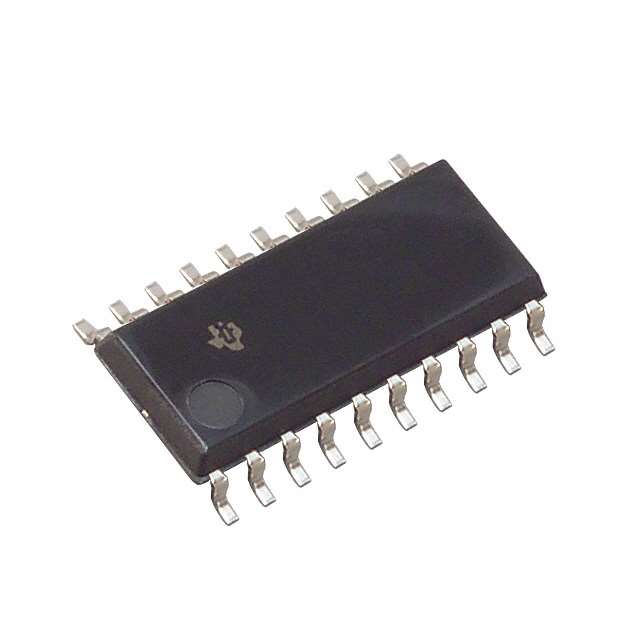Vedi le specifiche per i dettagli del prodotto.

SN74ALS299NSR
Product Overview
- Category: Integrated Circuit (IC)
- Use: Data Storage and Transfer
- Characteristics: High-speed, 8-bit Universal Shift/Storage Register
- Package: 20-pin Small Outline Integrated Circuit (SOIC)
- Essence: Serial-to-Parallel and Parallel-to-Serial Conversion
- Packaging/Quantity: Tape and Reel, 2500 units per reel
Specifications
- Logic Family: ALS
- Number of Bits: 8
- Operating Voltage: 4.5V to 5.5V
- Operating Temperature: -40°C to +85°C
- Propagation Delay: 10ns
- Output Current: ±24mA
- Input Voltage Levels: TTL Compatible
Detailed Pin Configuration
- SER (Serial Data Input)
- CLK (Clock Input)
- G (Enable Input)
- QH' (Serial Output)
- QA-QH (Parallel Outputs)
- VCC (Positive Power Supply)
- QH (Serial Output)
- MR (Master Reset)
- D (Parallel Data Inputs)
- CP (Parallel Load Clock)
- QH (Serial Output)
- QH' (Serial Output)
- QH (Serial Output)
- QH' (Serial Output)
- QH (Serial Output)
- QH' (Serial Output)
- QH (Serial Output)
- QH' (Serial Output)
- GND (Ground)
- QH' (Serial Output)
Functional Features
- Universal shift register with parallel load capability
- Serial-to-parallel and parallel-to-serial conversion
- Synchronous operation with a single clock input
- Asynchronous master reset for clearing the register
- High-speed operation with low propagation delay
- TTL compatible input voltage levels
- Buffered outputs for driving external loads
Advantages and Disadvantages
Advantages
- Versatile functionality for data storage and transfer applications
- High-speed operation allows for quick data processing
- Synchronous operation ensures accurate timing control
- Buffered outputs provide strong driving capability
- Wide operating temperature range for various environments
Disadvantages
- Limited to 8-bit data storage and transfer
- Requires external clock signal for proper operation
- Not suitable for low-power or battery-operated devices
Working Principles
The SN74ALS299NSR is a high-speed, 8-bit universal shift/storage register. It can perform serial-to-parallel and parallel-to-serial conversion of data. The register operates synchronously with a single clock input, allowing for precise timing control. It also features an asynchronous master reset input that clears the register to its initial state.
Data can be loaded into the register in parallel using the parallel load clock (CP) input. Once the data is loaded, it can be shifted out serially through the QH' and QH outputs. The register can also receive serial data through the SER input and shift it in parallel to the QA-QH outputs.
The buffered outputs of the SN74ALS299NSR provide strong driving capability, making it suitable for driving external loads such as LEDs, displays, or other logic circuits.
Detailed Application Field Plans
The SN74ALS299NSR can be used in various applications that require data storage and transfer. Some potential application fields include:
- Communication Systems: Used for serial-to-parallel and parallel-to-serial conversion in data communication systems.
- Data Processing: Enables efficient data storage and transfer in microprocessors and digital signal processors.
- Display Systems: Drives LED or LCD displays by converting serial data into parallel data.
- Control Systems: Provides shift register functionality for control signals in industrial automation systems.
Detailed and Complete Alternative Models
- SN74ALS298NSR: 8-bit universal shift/storage register with asynchronous parallel load capability.
- SN74ALS297NSR: 8-bit universal shift/storage register with serial-in/serial-out functionality.
- SN74ALS295NSR: 8-bit universal shift/storage register with parallel-in/serial-out functionality.
These alternative models offer similar functionality to the SN74ALS299NSR but may have different features or specifications that cater to specific application requirements.
Word count: 529 words
10 domande e risposte comuni relative all'applicazione di SN74ALS299NSR nelle soluzioni tecniche
Sure! Here are 10 common questions and answers related to the application of SN74ALS299NSR:
Q: What is SN74ALS299NSR? A: SN74ALS299NSR is a quad universal shift/storage register IC, commonly used in digital systems for data storage and shifting operations.
Q: What is the operating voltage range for SN74ALS299NSR? A: The operating voltage range for SN74ALS299NSR is typically between 4.5V and 5.5V.
Q: How many bits can SN74ALS299NSR store or shift? A: SN74ALS299NSR can store or shift up to 8 bits of data.
Q: Can SN74ALS299NSR be cascaded to increase the number of bits stored or shifted? A: Yes, SN74ALS299NSR can be cascaded to increase the number of bits by connecting the output of one IC to the input of another.
Q: What is the maximum clock frequency supported by SN74ALS299NSR? A: SN74ALS299NSR can support clock frequencies up to 25 MHz.
Q: Does SN74ALS299NSR have any built-in latches or flip-flops? A: Yes, SN74ALS299NSR has built-in D-type flip-flops that allow it to store data.
Q: Can SN74ALS299NSR operate in both parallel and serial modes? A: Yes, SN74ALS299NSR can operate in both parallel and serial modes, making it versatile for various applications.
Q: What is the power consumption of SN74ALS299NSR? A: The power consumption of SN74ALS299NSR is typically low, making it suitable for battery-powered devices.
Q: Can SN74ALS299NSR be used in both synchronous and asynchronous systems? A: Yes, SN74ALS299NSR can be used in both synchronous and asynchronous systems, depending on the application requirements.
Q: What are some typical applications of SN74ALS299NSR? A: SN74ALS299NSR is commonly used in applications such as data storage, parallel-to-serial or serial-to-parallel conversion, shift registers, and digital signal processing.
Please note that these answers are general and may vary based on specific datasheet specifications and application requirements.

